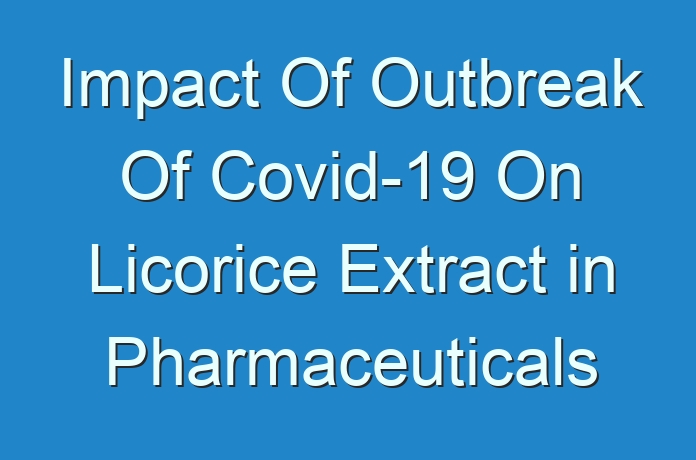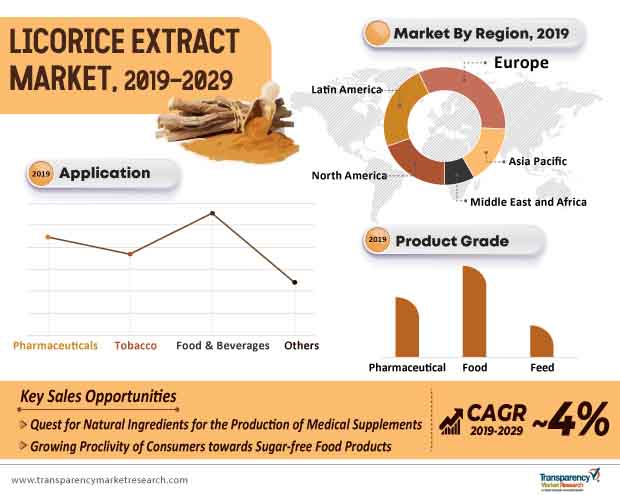
Licorice Extract Market – Investments toward Extraction Technology Remains a Coveted Strategy
Once popular as a weed, then as a concoction, and now being a legit natural sweetener, licorice extract has been making a prominent mark for itself in numerous industries. According to an exclusive study published by Transparency Market Research (TMR), the licorice extract market will remain relevant in pharmaceutical, tobacco, and food & beverage industries with its steady gait, and is anticipated to record a value of ~US$ 2.9 Bn by 2029, up from ~US$ 1.9 Bn in 2019.
Insights from the study show that, individuals with medical conditions such as obesity, diabetes, and high cholesterol account for a substantial share of the demand for licorice extract, with popular consumables being in the form of toothpastes, chewing gums, or sweeteners. As the once covert health benefits of licorice extract come to light, pharmaceutical and nutraceutical industries find an attractive market for penetrating nutritional products and dietary supplements to consumers seeking natural products to maintain their health.
Gaining a sense of enormous sales potential of licorice extract, companies are devising numerous product-level strategies to scale up their businesses. Among them, increasing the effectiveness of extraction technology remains a coveted strategy in the licorice extract market.
Request A Sample of Licorice Extract Market – https://www.transparencymarketresearch.com/sample/sample.php?flag=S&rep_id=18749

Cost-efficiency of Synthetic Sweeteners Could Impact Sales of Licorice Extract
Given the health implications regarding obesity and diabetes, medical personnel recommend individuals to control their sugar intake, which augurs well for low-calorie sweeteners. Being at the lower end of the price scale, the penetration of synthetic sweeteners has been growing, while the shift to natural sweeteners is currently only in its infancy stage.
Explore Transparency Market Research’S Award-Winning Coverage of the Global Food and Beverages Industry @ https://www.prnewswire.com/news-releases/aquafeed-additives-market-to-exhibit-5-cagr-to-reach-valuation-worth-us2-2-bn-by-2027-flourishing-aquaculture-domain-to-drive-growth-finds-tmr-301011577.html
Despite the switch of consumers toward organic products, end-use industries continue their high-scale adoption of artificial sweeteners. Take for instance the food and beverage industry. As the industry continues to experiment with unique flavors, the use of artificial sweeteners remains constant. The wide availability of artificial sweeteners in various forms such as cubes, granules, paste, liquid, and powder, alongside their cost-effectiveness, is likely to exert a negative influence on the sales of licorice extract.
Request for Covid-19 Impact Analysis @ https://www.transparencymarketresearch.com/sample/sample.php?flag=covid19&rep_id=18749
Microencapsulation – Key to Achieve Multiple End-use Applications
In order to match the pace of the ever-evolving preferences of consumers, manufacturers find themselves hard-pressed to bring innovative products to the table, and microencapsulation has lately acquired a significant amount of traction. Manufacturers are investing in microencapsulation technologies to protect the sweet sensation promoted by licorice extract. This technology especially finds huge prominence in the production of sugar-free chewing gums and chewable confections to prolong their sweet flavor during chewing.
As per the consumption trend, the powdered form of licorice extract will remain preferable over cubes and paste, given the ease of shipment and long shelf life. However, the preference for licorice extract in the semi-fluid form is likely to grow at an exponential rate, as end-use industries show a marked proclivity for readily-soluble forms.
Another striking feature of the market that players need to focus on is the large-scale adoption of licorice extract in the tobacco industry. The potential of licorice extract as a de-bittering agent is likely to drive sales in the tobacco industry. However, the food and beverage industry will continue to account for a leading share in the licorice extract market during the forecast period.





